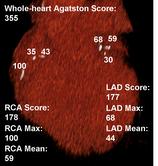Lesion-specific calcium score

The lesion-specific calcium score is a method of calcium measurement that results from a CT test for coronary artery calcification.
Coronary disease, which most often is equated with atherosclerotic coronary artery disease, has been identified as the leading cause of death worldwide. The initial presentation of coronary artery disease in half of all patients presents in sudden cardiac death outside of the hospital most often resulting in the patient’s death.
Early detection is critical in order to implement early lifestyle changes and early therapies to prevent major adverse coronary events. The most commonly used screening method for coronary disease is CT based coronary artery calcium quantification based on Agatston method, which was developed by Arthur Agatston. The Agatston score development was based upon the quantification of total coronary artery calcium in the entire heart for purposes of early detection and risk assessment.
The whole-heart Agatston score has been shown to be independent to traditional risk factors; however, the overall predictive accuracy is relatively modest as it does not take into consideration the spatial distribution and regional characteristics of individual calcified lesions. Furthermore, because it lacks spatial distribution information it cannot distinguish between plaque located in high risk areas versus low risk areas.
In 2008, Dr. Szilard Voros and his team began their investigation of the relationship between coronary calcification in the presence of blockages in the heart.[1] This investigation led to the concept of the lesion-specific calcium score. Voros, Dr. Zhen Qian and their team introduced this concept where each individual calcified lesion is characterized and precisely measured using parameters including but not limited to the width, length, density, and distance from the entrance of the major coronary arteries.[2] Research has shown that the lesion-specific calcium scoring method is superior to the traditional Agatston score for the prediction of significant blockages in the heart.[3] The lesion-specific calcium score has been filed under US and international patent protection.[4]
References
- ↑ http://www.springerlink.com/content/u6574wj164764730/
- ↑ http://ieeexplore.ieee.org/xpl/freeabs_all.jsp?arnumber=5193027
- ↑ http://www.journalofcardiovascularct.com/article/S1934-5925(10)00473-9/abstract
- ↑ http://appft.uspto.gov/netacgi/nph-ParserSect1=PTO1&Sect2=HITOFF&d=PG01&p=1&u=%2Fnetahtml%2FPTO%2Fsrchnum.html&r=1&f=G&l=50&s1=%222010015689822.PGNR.&OS=DN/20100156898&RS=DN/20100156898